What is Digital Marketing Analytics?
Definition and Overview
Digital marketing analytics refers to the process of collecting, analyzing, and interpreting data from various digital marketing efforts. This data-driven approach helps marketers measure the effectiveness of their campaigns, understand audience behavior, and make informed decisions to enhance their strategies. By leveraging tools like Google Analytics, SEMrush, and Hotjar, businesses gain actionable insights into website traffic, customer engagement, conversion rates, and more.
Importance of Digital Marketing Analytics
Understanding the significance of digital marketing analytics is crucial for modern businesses. Here’s why:
Track Customer Behavior and Preferences
One of the core benefits of digital marketing analytics is its ability to track customer behavior. By analyzing how users interact with websites, emails, and ads, businesses can:
- Identify popular pages and content.
- Understand user navigation paths.
- Track clicks, downloads, and form submissions.
This information enables companies to tailor their offerings to meet customer preferences, creating a personalized experience that drives engagement and loyalty.

Assess Campaign Performance in Granular Detail
Digital marketing analytics allows marketers to break down campaign performance into measurable metrics. Businesses can track:
- Click-through rates (CTR).
- Cost per acquisition (CPA).
- Return on investment (ROI).
With detailed insights, companies can identify what’s working and allocate budgets effectively to maximize results.
Try now FREE AI Digital Marketing SAS by Zooli.ai.
Optimize UX Design
User experience (UX) is central to a successful online presence. Analytics tools provide data on bounce rates, average session durations, and user flow, which helps in:
- Identifying friction points in the user journey.
- Optimizing website layout and design.
- Enhancing navigation for seamless user interaction.
Improved UX leads to higher customer satisfaction and better conversion rates.

Identify Growth Areas
Through digital marketing analytics, businesses can uncover untapped opportunities and areas for growth. By analyzing data trends, they can:
- Explore new market segments.
- Refine audience targeting.
- Predict future trends with machine learning algorithms.
Key Skills for a Career in Digital Marketing Analytics
A career in digital marketing analytics requires a mix of technical proficiency, critical thinking, and a deep understanding of marketing principles. Mastering the following key skills can set you apart in this rapidly evolving field.
Analytical Thinking
Analytical thinking is the foundation of digital marketing analytics. Professionals must be adept at:
- Breaking down complex data sets to uncover actionable insights.
- Recognizing patterns, trends, and anomalies in user behavior.
- Making data-driven decisions to optimize marketing efforts.
This skill enables marketers to ask the right questions, interpret data effectively, and connect the dots between different metrics to form a coherent strategy.

Data Interpretation
Understanding raw data is only the beginning; the ability to interpret this data is what truly matters. Key aspects include:
- Translating numbers and statistics into meaningful narratives.
- Identifying key performance indicators (KPIs) relevant to specific campaigns.
- Explaining findings to stakeholders in a clear and actionable manner.
- Try now FREE AI Digital Marketing SAS by Zooli.ai.
Marketers often rely on dashboards and reports to summarize data, making interpretation a vital skill for communicating value and success.
Proficiency in Tools like Google Analytics, SEMrush, and Mixpanel
Mastering digital marketing analytics tools is crucial for extracting insights and automating processes. Each tool offers unique features:
- Google Analytics: Tracks website traffic, user behavior, and conversion rates.
- SEMrush: Provides insights into SEO performance, keyword rankings, and competitor analysis.
- Mixpanel: Focuses on product and user analytics, tracking engagement and retention metrics.
Having hands-on experience with these tools not only enhances your technical skills but also ensures you can measure and improve marketing performance effectively.

Common Tools Used in Digital Marketing Analytics
Digital marketing analytics relies on various tools to measure, track, and optimize campaigns. These tools provide insights that help businesses make data-driven decisions. Below are some of the most commonly used tools and their applications.
Google Analytics
Google Analytics is one of the most widely used analytics tools, offering robust tracking and reporting features. It helps businesses:
- Understand website traffic sources, including organic, paid, and referral.
- Monitor user behavior such as page views, bounce rates, and session durations.
- Measure conversions and set up goals to track specific actions.
With its integration capabilities, Google Analytics provides a holistic view of online performance, making it indispensable for marketers.
SEMrush
SEMrush is a powerful tool for SEO and digital marketing analysis. It enables marketers to:
- Conduct keyword research to improve search engine rankings.
- Analyze competitors’ SEO strategies and identify gaps.
- Monitor backlink profiles and identify opportunities for improvement.
Its user-friendly interface and comprehensive reports make it a go-to tool for optimizing online visibility.

Moz
Moz specializes in SEO and is known for its intuitive interface and actionable insights. Its key features include:
- Domain Authority (DA) tracking to assess website credibility.
- On-page optimization suggestions to improve content.
- SERP analysis to evaluate how your site ranks for targeted keywords.
Moz’s features make it ideal for businesses looking to enhance their organic search performance.
Mixpanel
Mixpanel focuses on user behavior and product analytics. It helps businesses:
- Track user engagement and retention rates.
- Understand how users interact with products or services.
- Segment audiences based on behavior for targeted campaigns.
This tool is particularly valuable for apps and SaaS businesses aiming to improve customer satisfaction and retention.
Hotjar
Hotjar provides qualitative insights by focusing on user experience. It helps marketers:
- Analyze heatmaps to identify where users click and scroll.
- Conduct session recordings to observe user interactions.
- Gather feedback through surveys and polls.
Hotjar is essential for businesses looking to optimize website design and improve UX.
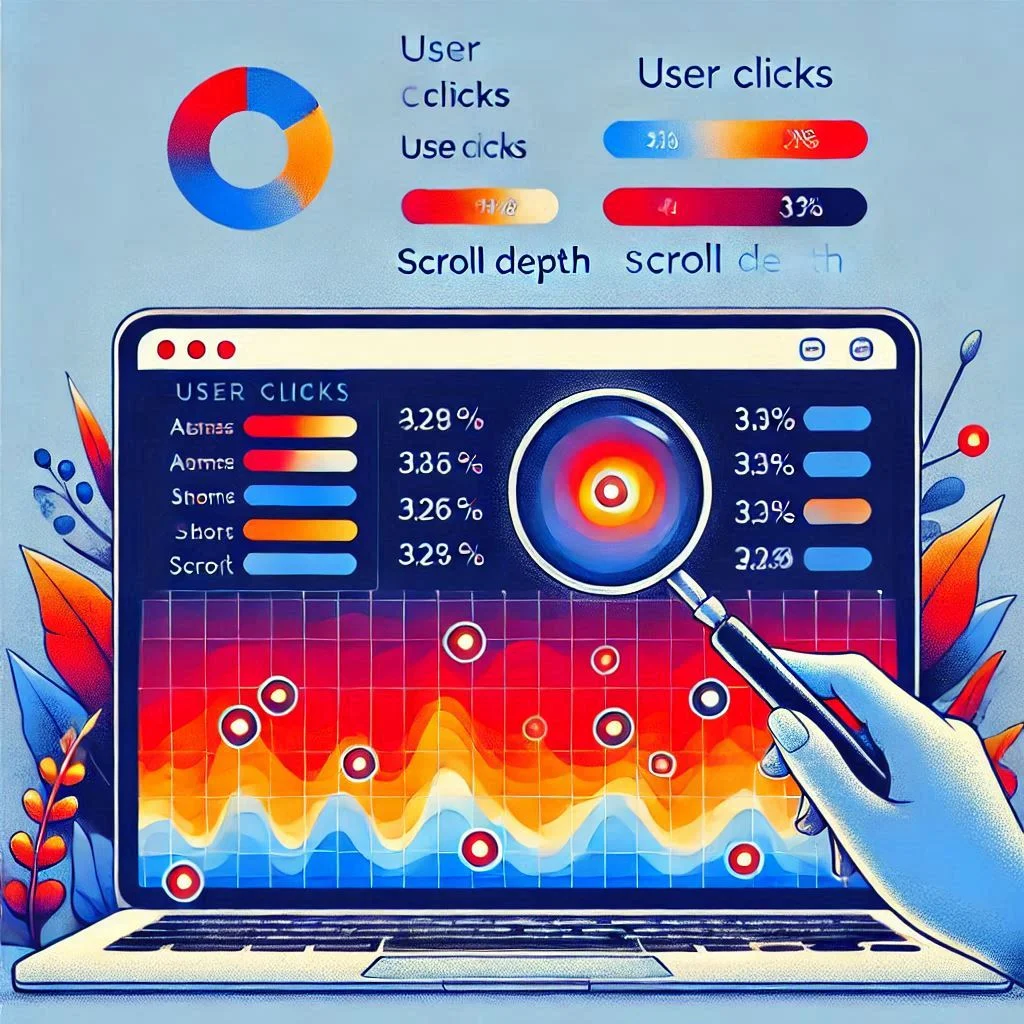
Techniques in Digital Marketing Analytics
Digital marketing analytics involves several advanced techniques to understand audience behavior, test strategies, and improve performance. Here are three fundamental techniques that every marketer should master.
Segmentation
Segmentation is the process of dividing a broad audience into smaller, more targeted groups based on shared characteristics. This technique allows marketers to:
- Personalize campaigns to meet the specific needs of different audience groups.
- Improve engagement rates by delivering relevant content.
- Measure the performance of each segment to identify high-performing demographics.
For example, an e-commerce website might segment users based on purchase history, geographic location, or browsing behavior. Effective segmentation leads to better targeting and higher ROI.
A/B Testing
A/B testing, also known as split testing, is a method of comparing two versions of a marketing element to determine which performs better. This technique helps in:
- Optimizing headlines, images, and call-to-action buttons.
- Identifying user preferences through measurable metrics like click-through rates and conversions.
- Reducing guesswork by relying on data-driven decisions.
For instance, testing two different landing page designs can reveal which layout drives more sales. A/B testing ensures continuous improvement and better results.
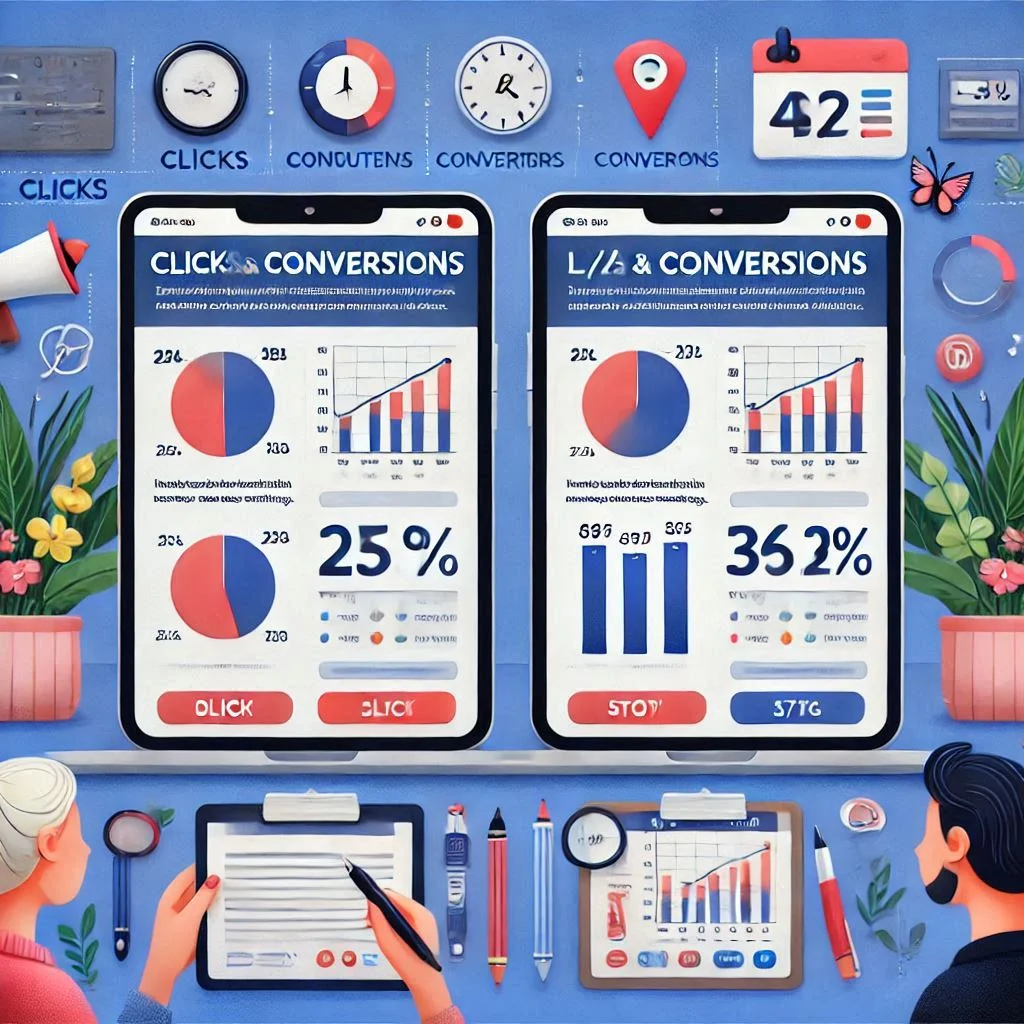
Conversion Rate Optimization (CRO)
Conversion Rate Optimization focuses on increasing the percentage of users who take a desired action, such as making a purchase, filling out a form, or subscribing to a newsletter. Key aspects of CRO include:
- Analyzing user behavior to identify drop-off points in the conversion funnel.
- Testing changes like simplified forms, faster loading times, or more compelling offers.
- Ensuring a seamless user experience to guide users toward conversions.
For example, an online store may optimize its checkout process by reducing unnecessary steps, leading to higher sales and fewer abandoned carts.
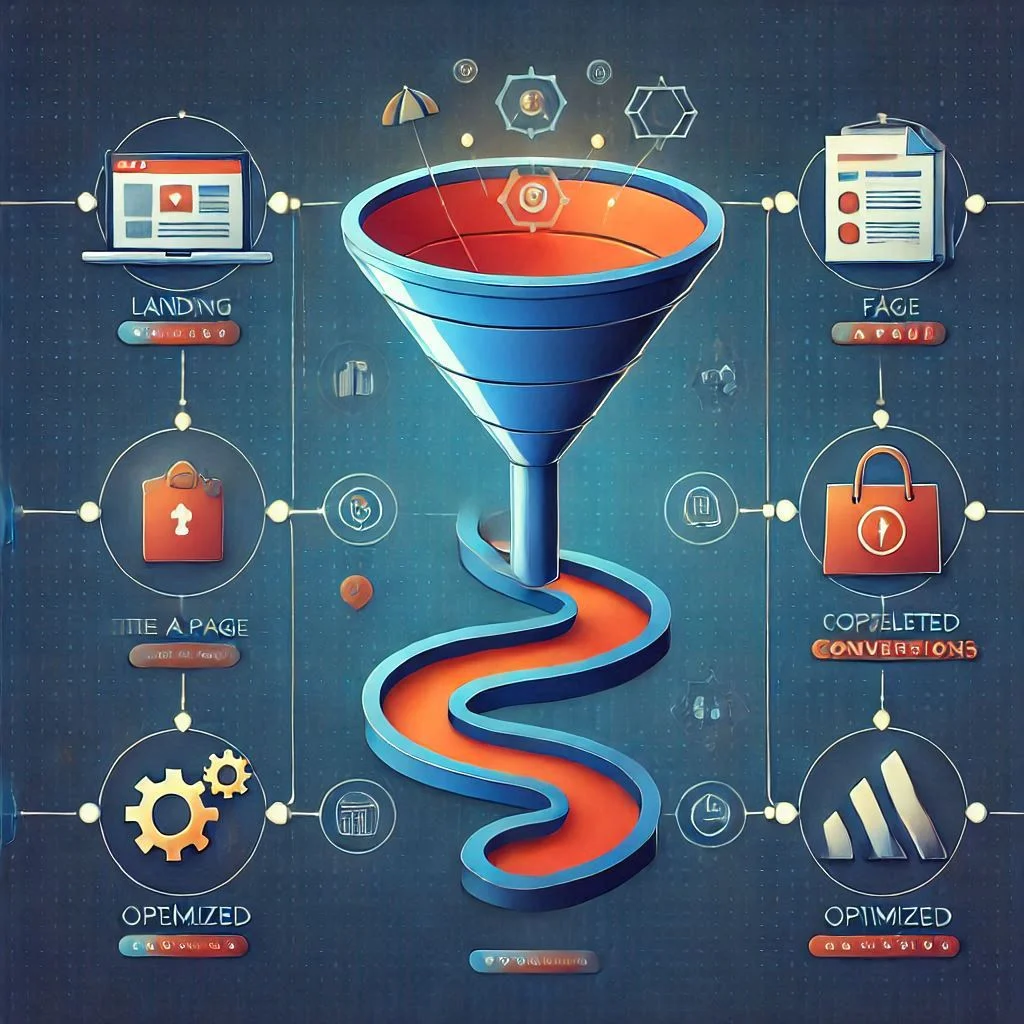
Key Metrics in Digital Marketing Analytics
Tracking the right metrics is essential for the success of digital marketing campaigns. Understanding the difference between actionable and vanity metrics, and identifying the key metrics for specific strategies, helps marketers make data-driven decisions.
Actionable Metrics vs. Vanity Metrics
What are Actionable Metrics?
Actionable metrics are data points that provide meaningful insights and directly impact decision-making. These metrics help you:
- Evaluate the effectiveness of your strategies.
- Identify areas for improvement.
- Make informed, data-driven decisions to enhance performance.
Examples of actionable metrics:
- Conversion rates.
- Customer acquisition cost (CAC).
- Return on investment (ROI).
What are Vanity Metrics?
Vanity metrics, on the other hand, are data points that may look impressive but do not provide significant value for decision-making. While they indicate activity, they often lack actionable insights.
Examples of vanity metrics:
- Total page views without engagement details.
- Social media followers without active participation.
- App downloads without tracking retention or usage.
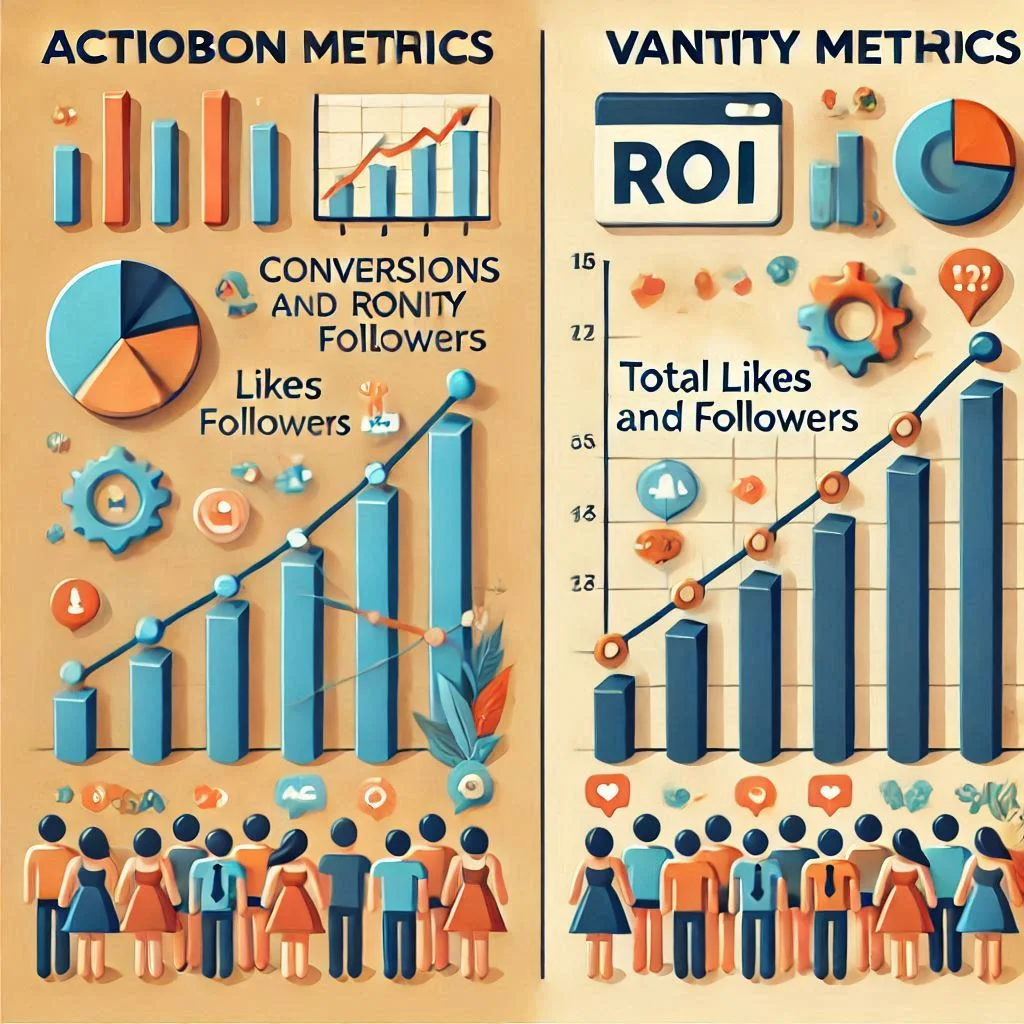
Metrics for Specific Campaigns
Content Marketing Metrics
Content marketing focuses on attracting and engaging audiences through valuable content. Key metrics include:
- Time on page: Indicates how engaging your content is.
- Bounce rate: Measures how often users leave without interacting.
- Social shares: Reflects the content’s shareability and reach.
- Organic traffic: Tracks visitors coming from search engines.
Social Media Campaign Metrics
Social media campaigns aim to build brand awareness and foster engagement. Key metrics include:
- Engagement rate: Measures likes, comments, and shares per post.
- Reach: Tracks the number of unique users who see your content.
- Click-through rate (CTR): Indicates how many users clicked on links.
- Conversions: Monitors actions like sign-ups or purchases from social media ads.
Email Campaign Metrics
Email campaigns focus on direct communication with your audience. Key metrics include:
- Open rate: Percentage of recipients who open your email.
- Click-through rate (CTR): Measures how many recipients click on links.
- Unsubscribe rate: Tracks the percentage of users opting out.
- Conversion rate: Indicates how many users complete the desired action.
E-commerce Website Metrics
E-commerce metrics track the performance of online stores. Key metrics include:
- Cart abandonment rate: Tracks users leaving without completing purchases.
- Average order value (AOV): Measures the average revenue per order.
- Customer lifetime value (CLV): Indicates the total revenue a customer generates.
- Product views: Tracks interest in individual items.

Lead Generation Metrics
Lead generation campaigns focus on capturing prospects’ information. Key metrics include:
- Cost per lead (CPL): Measures how much you spend to generate each lead.
- Lead conversion rate: Tracks the percentage of leads turning into customers.
- Landing page conversion rate: Indicates how well your pages convert visitors.
- Qualified leads: Counts leads ready for sales follow-up.
Applications of Digital Marketing Analytics
Digital marketing analytics is a cornerstone for driving successful campaigns and achieving business goals. By leveraging data effectively, marketers can optimize their strategies, allocate resources efficiently, and deliver personalized experiences. Below are key applications of digital marketing analytics.
Identifying High-Performing Campaigns
Digital marketing analytics helps pinpoint which campaigns deliver the best results. By analyzing data such as conversion rates, click-through rates (CTR), and ROI, marketers can:
- Recognize which strategies are driving traffic and sales.
- Replicate successful elements in future campaigns.
- Shift focus and resources to the most impactful initiatives.
For instance, identifying the top-performing ad copy or keyword can guide the optimization of similar campaigns.
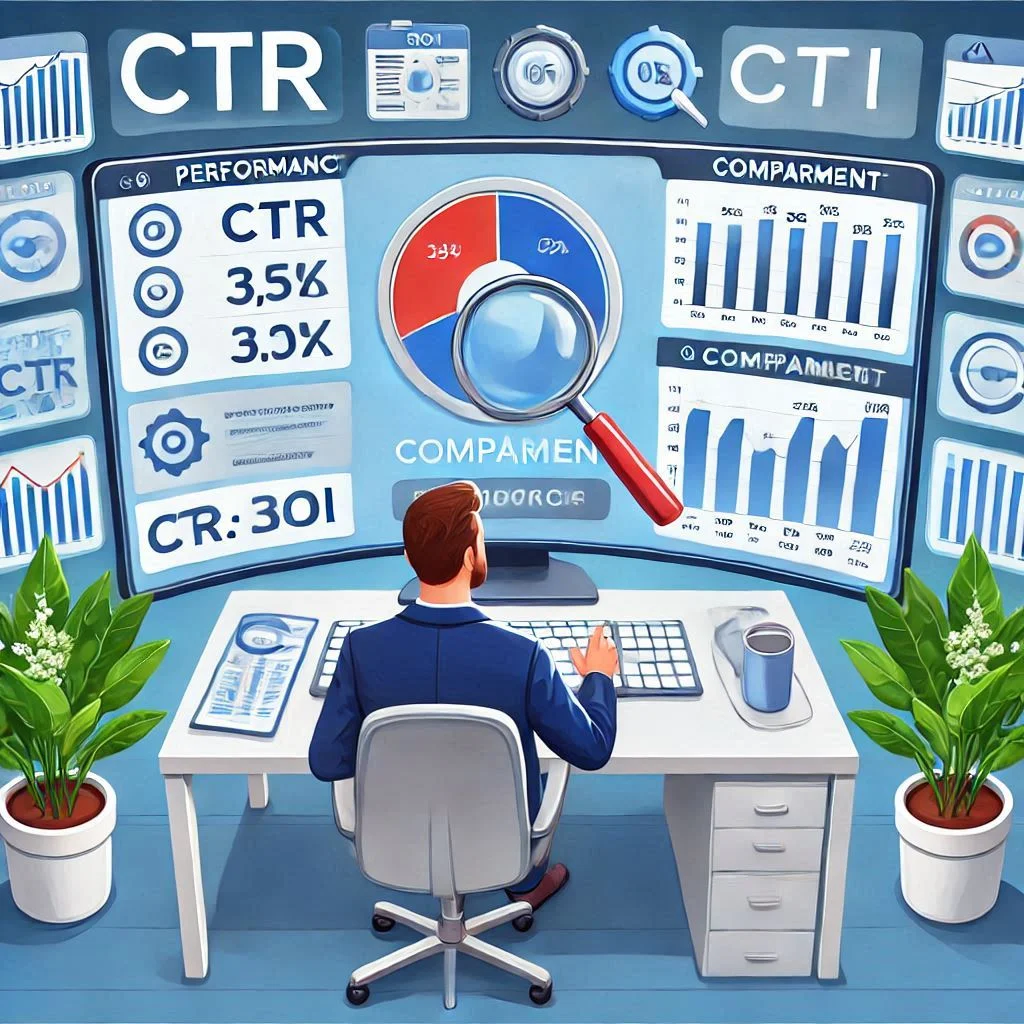
Optimizing Campaigns
Optimization is at the heart of digital marketing analytics. By continuously tracking metrics, marketers can refine strategies in real-time, such as:
- Adjusting ad targeting to reach the most relevant audience.
- Modifying content to align with user preferences.
- Testing variations using A/B testing to identify what works best.
For example, optimizing landing pages by analyzing user interactions can lead to higher conversions.
Monitoring and Adjusting Spend
Effective budget allocation is crucial for maximizing ROI. Digital marketing analytics helps in:
- Tracking ad spend and comparing it to performance metrics.
- Identifying campaigns with diminishing returns.
- Reallocating budgets to high-performing channels or campaigns.
For instance, a social media campaign underperforming on Facebook might have its budget shifted to Instagram ads showing better engagement.

Personalizing the Customer Experience
Analytics enables personalized marketing by analyzing customer behavior and preferences. Personalization includes:
- Delivering tailored product recommendations.
- Crafting email campaigns with customized messaging.
- Creating dynamic ads that adapt to user interests.
Personalization not only improves engagement but also fosters loyalty and trust among customers.
Improving Website Performance
A well-optimized website is essential for user satisfaction and conversions. Analytics tools like Google Analytics and Hotjar help improve website performance by:
- Identifying pages with high bounce rates.
- Analyzing user journeys to spot bottlenecks.
- Testing design elements to enhance usability.
For example, reducing page load times or simplifying navigation can significantly boost user satisfaction and conversion rates.
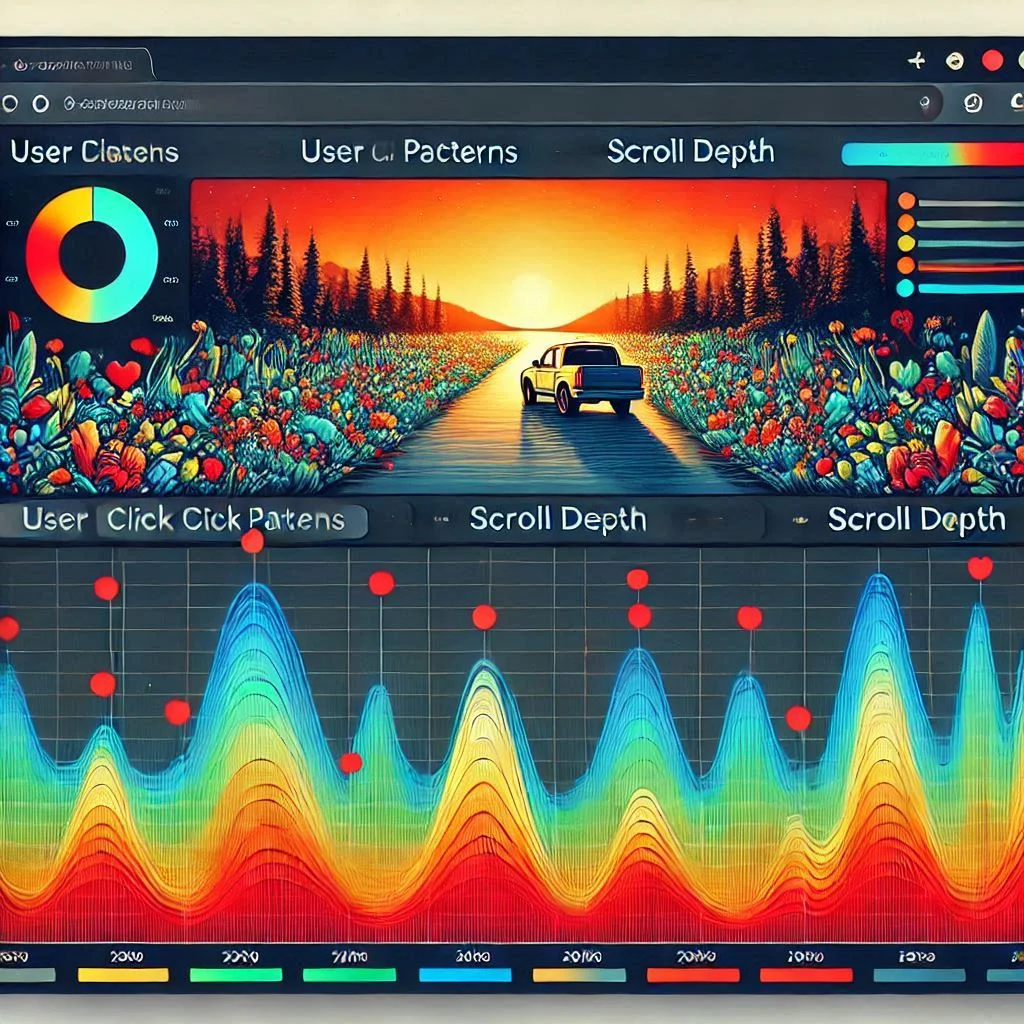
How to Use Digital Marketing Analytics in Your Strategy
Leveraging digital marketing analytics effectively requires a structured approach. Following a step-by-step methodology ensures that your campaigns are data-driven, efficient, and aligned with business goals. Here’s how to incorporate digital marketing analytics into your strategy.
Step 1: Set Your Objectives and Select Appropriate Metrics
The foundation of any analytics-driven strategy is a clear set of objectives. Ask yourself:
- What are you trying to achieve? (e.g., increase sales, drive traffic, boost engagement).
- What key performance indicators (KPIs) will help you measure success?
For example, if your goal is to improve website conversions, you might track metrics such as bounce rates, conversion rates, and average session duration. Defining objectives ensures that your analytics efforts remain focused and relevant.

Step 2: Choose the Right Tools
Select tools that align with your business needs and objectives. Popular options include:
- Google Analytics for website performance.
- SEMrush for SEO and competitive analysis.
- Hotjar for user behavior tracking.
- Mixpanel for product analytics.
Having the right tools enables you to collect, visualize, and interpret data effectively, ensuring a deeper understanding of your audience.
Try now FREE AI Digital Marketing SAS by Zooli.ai.
Step 3: Benchmark the Current State
Before making improvements, establish a baseline by analyzing your current performance.
- Review historical data to identify trends.
- Analyze competitor performance for industry benchmarks.
- Highlight areas of strength and weakness.
Benchmarking helps you understand where you stand and provides a reference point for measuring future improvements.

Step 4: Collect and Analyze New Data
Once you’ve set objectives and established benchmarks, start collecting data.
- Use tools to gather data from all channels (e.g., website, email, social media).
- Segment your audience to uncover trends and preferences.
- Analyze the data for actionable insights.
For example, analyzing user paths through your website can reveal drop-off points that need optimization.
Step 5: Monitor, Adjust, and Make Decisions
Digital marketing analytics is an ongoing process. Continuously monitor your data to ensure alignment with your goals:
- Identify what’s working and double down on successful strategies.
- Adjust campaigns in real time based on performance insights.
- Be ready to make tough decisions, like reallocating budget or stopping underperforming campaigns.
For instance, if a paid ad campaign is underperforming, consider reallocating its budget to organic content strategies that show better engagement.

How to Build a Career in Digital Marketing Analytics
A career in digital marketing analytics offers dynamic growth opportunities in today’s data-driven world. To excel, you need to combine technical skills, hands-on experience, and continuous learning. Below is a comprehensive guide to building a rewarding career in this field.
Get Training
Training is the first step to mastering the fundamentals of digital marketing analytics. Consider the following:
- Enroll in online courses: Platforms like Coursera, Udemy, and Google Skillshop offer certifications in tools like Google Analytics, SEO, and data visualization.
- Learn data analytics tools: Familiarize yourself with tools such as Tableau, Excel, Python, and SQL to handle and analyze large datasets.
- Stay updated on marketing trends: Understand concepts like customer journey mapping, marketing funnels, and multi-channel attribution.
Pro Tip: Focus on certifications from industry leaders like Google or HubSpot to enhance your credibility.

Gain Real-World Marketing Experience
Practical experience bridges the gap between theory and application. You can:
- Intern with agencies or companies: Work on live projects to understand how analytics influence decision-making.
- Freelance for small businesses: Offer analytics services to build hands-on expertise and refine your skills.
- Work on personal projects: Create a blog or run a small e-commerce website to practice tracking metrics and optimizing campaigns.
Practical experience provides insights into real-world challenges, helping you develop problem-solving skills.
Build a Portfolio
A well-organized portfolio demonstrates your skills and achievements to potential employers. Include the following:
- Case studies: Highlight successful campaigns you’ve worked on, detailing your role, the metrics you analyzed, and the results achieved.
- Tool expertise: Showcase your proficiency with tools like Google Analytics, SEMrush, or Mixpanel.
- Data visualizations: Use platforms like Tableau or Excel to present actionable insights in an easy-to-understand format.
Your portfolio should reflect your ability to turn raw data into meaningful business outcomes.

Network
Building a professional network can open doors to job opportunities and collaborations.
- Join industry groups: Participate in online communities like LinkedIn groups focused on digital marketing analytics.
- Attend events and webinars: Connect with professionals at conferences, seminars, and virtual events.
- Engage on social media: Share insights, comment on industry trends, and engage with thought leaders to grow your visibility.
Networking helps you stay updated and gain insider knowledge about the industry.
Stay Up-to-Date with Industry Trends
The digital marketing landscape is constantly evolving. To stay ahead:
- Follow industry blogs and publications: Subscribe to sites like MarketingProfs, Moz, and HubSpot.
- Explore new tools: Experiment with emerging analytics tools and techniques to expand your skill set.
- Join online communities: Platforms like Reddit and specialized Slack groups often discuss the latest trends and tools.
Continuous learning ensures that your knowledge remains relevant in this rapidly changing field.

FAQs
Q1: What qualifications are required to start a career in digital marketing analytics?
While a degree in marketing, business, or data analytics is beneficial, many professionals transition into the field with certifications and hands-on experience. Tools like Google Analytics and courses in data visualization or SQL can give you a strong foundation.
Q2: Do I need to know programming languages to succeed in digital marketing analytics?
Basic knowledge of programming languages like Python, R, or SQL can be advantageous, especially for data manipulation and automation, but it’s not mandatory for entry-level roles.
Q3: How important are certifications in this field?
Certifications, particularly from reputable platforms like Google or HubSpot, validate your skills and enhance your resume, making them valuable for standing out in the job market.
Q4: Which tools should I focus on mastering?
Start with foundational tools like Google Analytics, SEMrush, and Hotjar. As you progress, consider learning Tableau, Excel, and CRM platforms like Salesforce for advanced analytics.
Q5: How can I transition to digital marketing analytics from another field?
Build foundational knowledge through online courses, gain hands-on experience via freelancing or internships, and network with industry professionals to facilitate your transition.
Q6: Is digital marketing analytics a growing field?
Yes, with businesses increasingly relying on data-driven decisions, demand for digital marketing analysts continues to rise, offering excellent career prospects.

Conclusion
Digital marketing analytics is an essential component of modern marketing strategies, enabling businesses to make data-driven decisions that enhance performance, optimize campaigns, and personalize customer experiences. By mastering the key skills, tools, and techniques discussed, aspiring professionals can build successful careers in this rapidly growing field. From setting clear objectives to continuously learning and adapting to new trends, the journey in digital marketing analytics is both rewarding and dynamic. Whether you’re just starting out or looking to advance your career, applying the right approach to analytics will set you apart and help you achieve long-term success in the competitive digital landscape.

